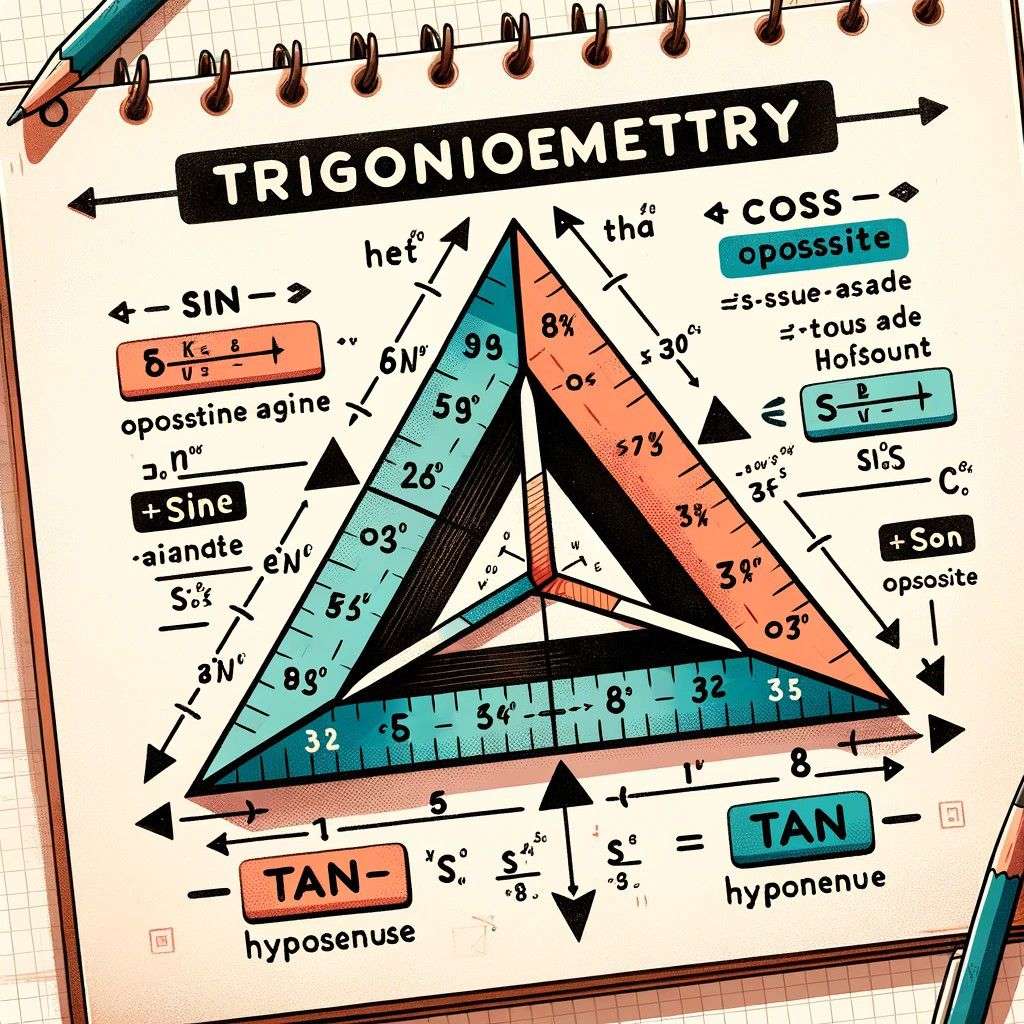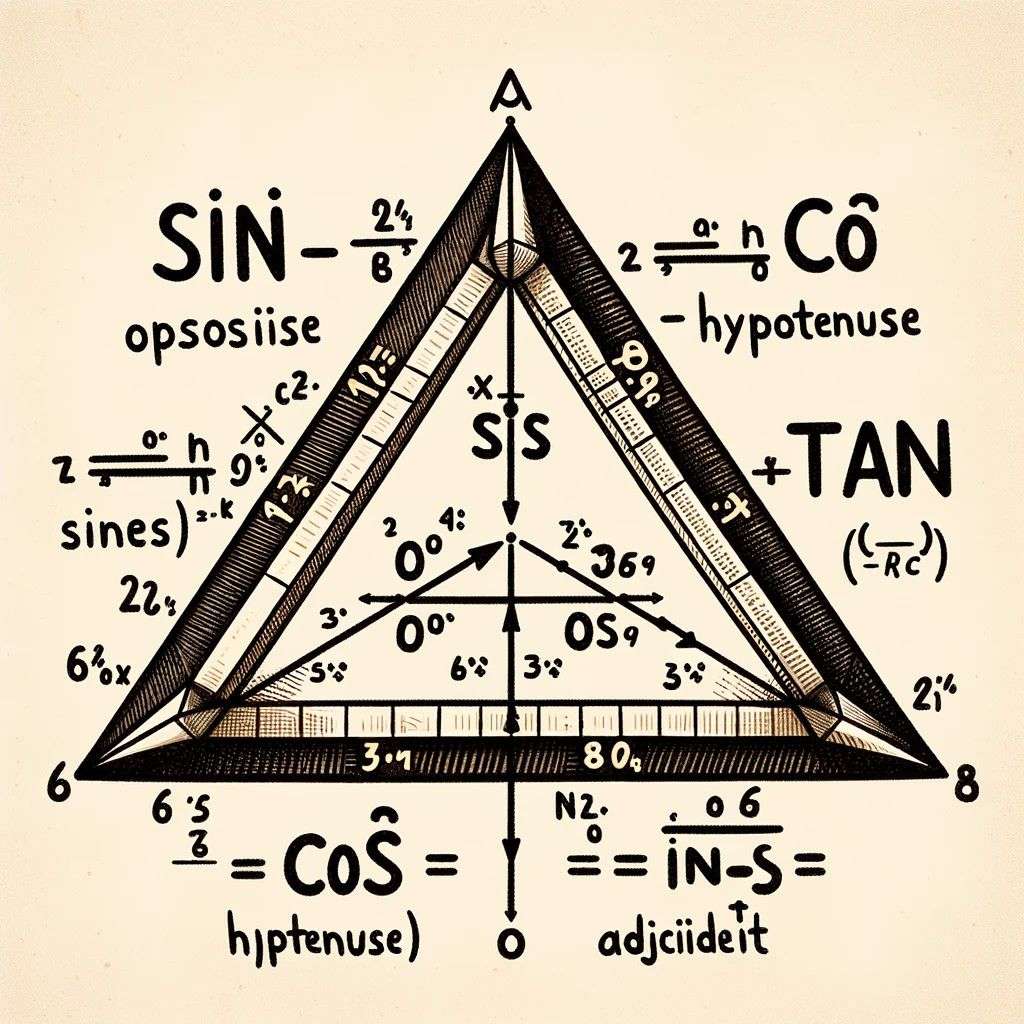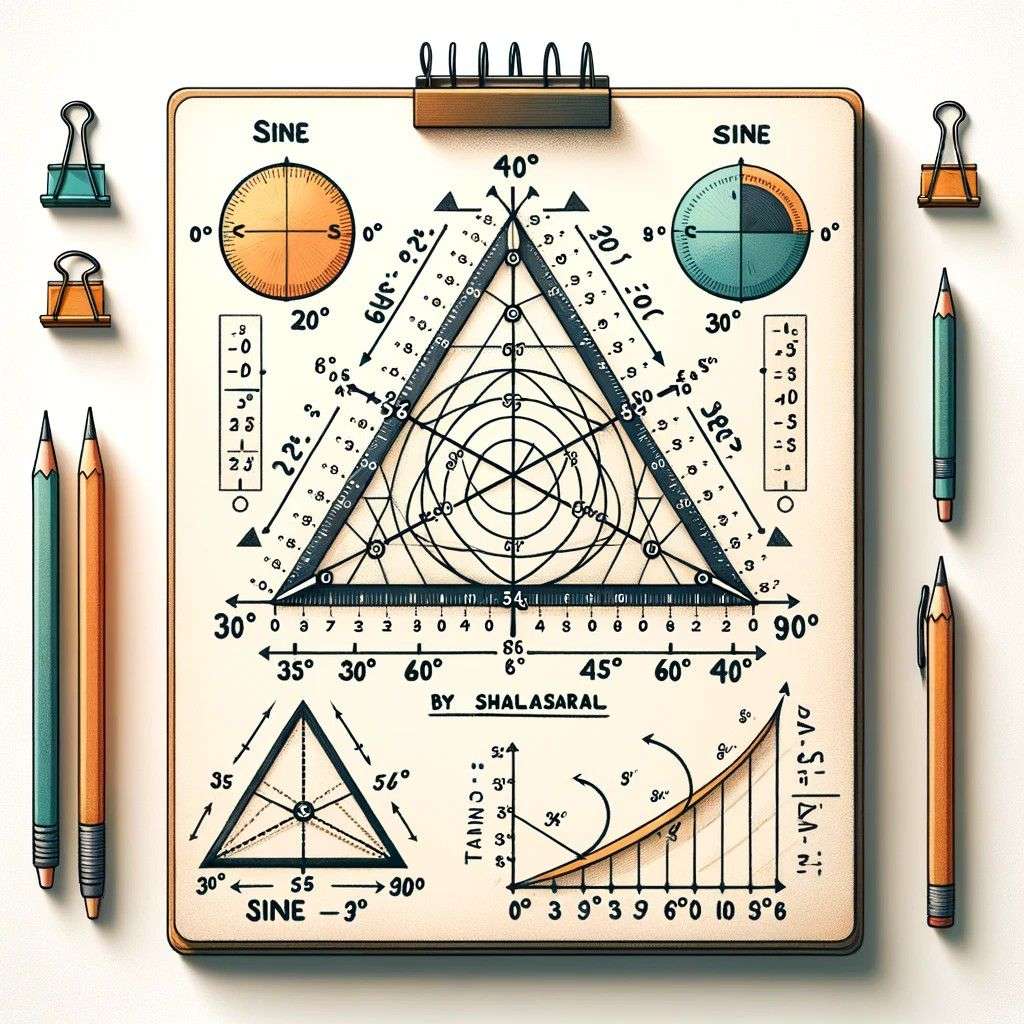
Mastering Trigonometry: Essential Concepts and Real-World Applications for Class 10 Students

1. Introduction to Trigonometry (Class 10 Maths, NCERT)
Definition and Historical Background:
- Definition: Trigonometry is a branch of mathematics that focuses on the study of the relationships between the angles and lengths of triangles, especially right-angled triangles. The word ‘trigonometry’ itself comes from the Greek words ‘trigonon’ (meaning triangle) and ‘metron’ (meaning measure).
- Historical Background: Trigonometry’s origins can be traced back to ancient civilizations, including the Greeks and Indians. It was initially developed for astronomical purposes and to solve practical problems in surveying and navigation. The Greek astronomer Hipparchus is often considered the founder of trigonometry, and Indian mathematician Aryabhata’s work on trigonometric functions was also significant.
Importance in Mathematics:
- Foundation for Advanced Studies: Trigonometry forms a fundamental part of modern mathematics. It is crucial for the study of calculus, physics, and engineering. Understanding trigonometry is essential for higher-level math and science courses.
- Practical Applications: Beyond theoretical mathematics, trigonometry has practical applications in various fields like architecture, physics, engineering, computer graphics, and even music theory.
- Problem Solving: Trigonometry is particularly useful in solving problems involving right-angled triangles, where one needs to calculate either a side length or an angle.
- Astronomy and Navigation: Historically, trigonometry was vital in astronomy for calculating distances to stars and planets. It’s also essential in navigation for determining the position of a ship or an airplane.
The study of trigonometry in Class 10 lays the groundwork for these applications and more complex mathematical studies in the future.
2. Basic Concepts of Trigonometry
Understanding Right-Angled Triangles:
- A right-angled triangle is a triangle where one of the angles measures exactly 90 degrees.
- The longest side opposite the right angle is known as the hypotenuse.
- The sides that form the right angle are called the legs of the triangle, often referred to as the ‘adjacent’ and ‘opposite’ sides relative to the angle of interest.
Introduction to Trigonometric Ratios: Sine, Cosine, and Tangent:
- Sine (sin): The sine of an angle in a right-angled triangle is defined as the ratio of the length of the opposite side to the length of the hypotenuse. Mathematically, (\sin(\theta) = \frac{\text{Opposite}}{\text{Hypotenuse}}).
- Cosine (cos): The cosine of an angle is the ratio of the length of the adjacent side to the hypotenuse. Expressed as (\cos(\theta) = \frac{\text{Adjacent}}{\text{Hypotenuse}}).
- Tangent (tan): The tangent of an angle is the ratio of the length of the opposite side to the adjacent side. It is given by (\tan(\theta) = \frac{\text{Opposite}}{\text{Adjacent}}).

Concept of Opposite, Adjacent, and Hypotenuse:
- Opposite Side: In a right-angled triangle, the side opposite the angle of interest (other than the right angle) is the opposite side.
- Adjacent Side: This is the side that forms the angle of interest with the hypotenuse.
- Hypotenuse: The longest side of the right-angled triangle, opposite the right angle.
These basic concepts form the foundation of trigonometry, enabling students to understand and calculate various properties and measurements in right-angled triangles. Trigonometric ratios are essential tools not only in mathematics but also in various practical applications where angles and distances need to be calculated or analyzed.
3. Trigonometric Ratios
Calculation of Sine (sin), Cosine (cos), and Tangent (tan):
- Sine (sin): For an angle ( \theta ) in a right-angled triangle, ( \sin(\theta) ) is the ratio of the length of the opposite side to the hypotenuse. Formula: ( \sin(\theta) = \frac{\text{Opposite}}{\text{Hypotenuse}} ).
- Cosine (cos): ( \cos(\theta) ) is the ratio of the length of the adjacent side to the hypotenuse. Formula: ( \cos(\theta) = \frac{\text{Adjacent}}{\text{Hypotenuse}} ).
- Tangent (tan): ( \tan(\theta) ) is the ratio of the length of the opposite side to the adjacent side. Formula: ( \tan(\theta) = \frac{\text{Opposite}}{\text{Adjacent}} ).

Trigonometric Tables and Their Use:
- Trigonometric tables list the values of sine, cosine, and tangent functions for various angles.
- They are used to find the values of these functions when solving trigonometry problems, especially before the widespread availability of calculators.
- The tables are generally organized for angles from 0° to 90° due to the symmetric properties of trigonometric functions.
Reciprocal Trigonometric Ratios: Cosecant, Secant, and Cotangent:
- Cosecant (csc): The reciprocal of sine. ( \csc(\theta) = \frac{1}{\sin(\theta)} = \frac{\text{Hypotenuse}}{\text{Opposite}} ).
- Secant (sec): The reciprocal of cosine. ( \sec(\theta) = \frac{1}{\cos(\theta)} = \frac{\text{Hypotenuse}}{\text{Adjacent}} ).
- Cotangent (cot): The reciprocal of tangent. ( \cot(\theta) = \frac{1}{\tan(\theta)} = \frac{\text{Adjacent}}{\text{Opposite}} ).
Understanding these trigonometric ratios and their reciprocals is crucial for solving a wide range of trigonometric problems, not only in pure mathematics but also in various applied fields.
4. Trigonometric Identities
Fundamental Trigonometric Identities and Their Proofs:
- Pythagorean Identity: One of the most fundamental identities is the Pythagorean identity, which states that for any angle ( \theta ), ( \sin^2(\theta) + \cos^2(\theta) = 1 ). This identity derives from the Pythagorean theorem applied to a right-angled triangle with a hypotenuse of length 1.
- Reciprocal Identities: These relate the primary trigonometric functions to their reciprocals.
- ( \csc(\theta) = \frac{1}{\sin(\theta)} )
- ( \sec(\theta) = \frac{1}{\cos(\theta)} )
- ( \cot(\theta) = \frac{1}{\tan(\theta)} )
- Quotient Identity: This identity relates tangent and cotangent to sine and cosine.
- ( \tan(\theta) = \frac{\sin(\theta)}{\cos(\theta)} )
- ( \cot(\theta) = \frac{\cos(\theta)}{\sin(\theta)} )
Applications of Trigonometric Identities in Simplifying Expressions:
- Trigonometric identities are used extensively in simplifying trigonometric expressions, solving equations, and in calculus.
- They help in transforming expressions to a more convenient form for solving. For instance, if an expression involves sin²(θ) and cos²(θ), it can often be simplified using the Pythagorean identity.
- In calculus, these identities are crucial for integrating and differentiating trigonometric functions.
- They are also used in physics and engineering to solve problems involving periodic functions, like waves and oscillations.
Understanding and applying trigonometric identities is a key skill in mathematics, enabling more complex problems to be solved more easily and providing a deeper insight into the properties of trigonometric functions.
5. Heights and Distances
Practical Applications of Trigonometry in Determining Heights and Distances:
- Trigonometry is extensively used in real-life applications to determine heights and distances that are not easily measurable directly.
- This application primarily involves the use of trigonometric ratios in right-angled triangles.
Solving Problems Involving Angles of Elevation and Depression:

- Angle of Elevation: The angle of elevation is the angle between the horizontal line of sight and the line of sight up to an object. For example, if you look up at the top of a building, the angle your line of sight makes with the horizontal is the angle of elevation.
- Angle of Depression: Conversely, the angle of depression is the angle between the horizontal line of sight and the line of sight down to an object. For instance, viewing an object on the ground from a balcony, the angle your line of sight makes with the horizontal is the angle of depression.
- Solving Problems: To solve these problems, one typically uses the trigonometric ratios. For instance, if the angle of elevation and the distance from the point of observation to the base of the object are known, the height of the object can be determined using the tangent ratio.
- Example Problem: Consider a tree standing vertically on the ground. From a point 40 meters away from the base of the tree, the angle of elevation to the top of the tree is found to be 30 degrees. Using the tangent ratio, the height of the tree can be calculated as follows:
[ \tan(30^\circ) = \frac{\text{Height of the Tree}}{40 \text{ m}} ]
Using the value of ( \tan(30^\circ) ), the height of the tree can be determined.
This practical application of trigonometry is not only fundamental in mathematics but also in fields such as engineering, astronomy, geography, and physics, where such calculations are essential.
6. Trigonometric Ratios of Specific Angles
Calculation and Application of Trigonometric Ratios for 0°, 30°, 45°, 60°, and 90°:
- Trigonometric ratios for specific angles are fundamental in trigonometry. Here are the values for sine, cosine, and tangent at commonly used angles:
- 0°:
- ( \sin(0°) = 0 )
- ( \cos(0°) = 1 )
- ( \tan(0°) = 0 )
- 30° (or π/6):
- ( \sin(30°) = \frac{1}{2} )
- ( \cos(30°) = \frac{\sqrt{3}}{2} )
- ( \tan(30°) = \frac{\sqrt{3}}{3} )
- 45° (or π/4):
- ( \sin(45°) = \frac{\sqrt{2}}{2} )
- ( \cos(45°) = \frac{\sqrt{2}}{2} )
- ( \tan(45°) = 1 )
- 60° (or π/3):
- ( \sin(60°) = \frac{\sqrt{3}}{2} )
- ( \cos(60°) = \frac{1}{2} )
- ( \tan(60°) = \sqrt{3} )
- 90° (or π/2):
- ( \sin(90°) = 1 )
- ( \cos(90°) = 0 )
- ( \tan(90°) ) is undefined.
- These values are derived from the unit circle and right-angled triangles with specific angle measures.

Use of Trigonometric Ratios in Geometry Problems:
- These specific trigonometric ratios are used extensively in solving geometry problems. They help in calculating unknown sides or angles in right-angled triangles.
- In more complex problems, these ratios are used to simplify expressions or solve for unknown variables.
- Understanding these values is crucial for problems involving periodic functions, wave motion, and circular motion in physics.
Knowledge of these specific angle trigonometric ratios is not only a key aspect of solving trigonometry problems in mathematics but also forms the basis for understanding more advanced concepts in calculus and physics.
7. Applications of Trigonometry
Use in Real Life:
- Architecture and Engineering: Trigonometry is vital in designing and constructing buildings, bridges, and other structures. It helps in calculating angles, determining structural loads, and ensuring stability and safety.
- Astronomy: Historically significant in astronomy, trigonometry is used to calculate distances to stars and planets, understand the movement of celestial bodies, and map out the universe.
- Navigation: Essential for navigation, particularly in aviation and maritime. Trigonometry helps in calculating course directions, distances traveled, and positions using GPS and other navigational systems.
- Geography and Cartography: In geography, trigonometry is used for land surveying and mapping. It aids in measuring distances between geographical locations.
- Physics: In physics, trigonometric functions describe wave patterns, oscillations, and can determine forces and velocities in mechanics.
Relevance in Other Areas of Mathematics and Science:
- Computer Graphics: Trigonometry is used in computer graphics for rendering images, animations, and in developing video games. It is crucial for determining perspectives, creating realistic movements, and simulating physical phenomena.
- Medical Imaging: In medical imaging technologies like MRI and ultrasound, trigonometry helps in reconstructing images from the data collected by the machines.
- Electrical Engineering: Trigonometry is fundamental in electrical engineering, particularly in understanding alternating current circuits, where sine and cosine waves model voltage and current variations over time.
- Statistics and Data Analysis: Trigonometric functions are used in statistical methods and data analysis to model periodic phenomena.
- Music Theory: In music, trigonometry can be used to understand sound waves and harmonics, thus contributing to acoustics and audio engineering.
The applications of trigonometry are vast and span across many fields, highlighting its importance as a fundamental mathematical tool. Its concepts not only provide solutions to practical problems but also contribute to advancements in technology and science.
8. Practice Problems and Solutions
Range of Exercise Problems:
To solidify understanding of trigonometry concepts, it’s important to engage with a variety of problems. These can include:
- Basic Trigonometric Calculations: Solving for unknown sides or angles in right-angled triangles using trigonometric ratios.
- Trigonometric Identities: Simplifying expressions or proving identities using fundamental trigonometric identities.
- Heights and Distances: Using angles of elevation and depression to determine unknown heights or distances.
- Real-World Applications: Problems based on real-life scenarios that involve the application of trigonometry in fields like architecture, astronomy, or navigation.
- Advanced Problems: Challenges involving inverse trigonometric functions, trigonometric equations, and problems combining trigonometry with other areas of mathematics.
Step-by-Step Solutions for Better Understanding:
- Example Problem 1: Find the length of the side opposite to a 30° angle in a right-angled triangle with a hypotenuse of 10 cm.
- Solution: Use the sine function.
- ( \sin(30°) = \frac{\text{Opposite}}{10} )
- ( \frac{1}{2} = \frac{\text{Opposite}}{10} )
- ( \text{Opposite} = 5 \text{ cm} )
- Example Problem 2: Prove that ( \cos^2(\theta) + \sin^2(\theta) = 1 ) for any angle ( \theta ).
- Solution: Use the Pythagorean identity, derived from the Pythagorean theorem applied to a right-angled triangle.
- Example Problem 3: Find the height of a building if the angle of elevation from a point 50 m away from its base is 45°.
- Solution: Use the tangent function.
- ( \tan(45°) = \frac{\text{Height}}{50} )
- ( 1 = \frac{\text{Height}}{50} )
- ( \text{Height} = 50 \text{ m} )
These examples demonstrate the range of problems one can expect in a study of trigonometry. Step-by-step solutions help in better understanding the application of concepts and methods.
9. Summary and Key Takeaways
Recap of Major Concepts Covered:
- Fundamental Concepts: Introduction to the basics of trigonometry, focusing on right-angled triangles, and the definition and calculation of trigonometric ratios: sine, cosine, and tangent.
- Trigonometric Ratios and Identities: Exploration of fundamental identities like the Pythagorean identity, reciprocal identities, and quotient identities. Understanding these identities is crucial for simplifying and solving trigonometric expressions.
- Heights and Distances: Application of trigonometry in practical problems involving angles of elevationand depression, allowing for the calculation of heights and distances in various real-world scenarios.
- Specific Angle Trigonometric Ratios: Study of the trigonometric ratios for specific angles (0°, 30°, 45°, 60°, and 90°) and their application in solving problems.
- Applications in Various Fields: Understanding how trigonometry is used in different real-life situations such as architecture, astronomy, navigation, and many other fields.
Importance of Trigonometry in Higher Studies:
- Foundation for Advanced Mathematics: Trigonometry is not just an isolated branch of mathematics; it forms a fundamental part of more advanced studies in calculus, algebra, and geometry. It provides the necessary tools for understanding complex mathematical concepts.
- Essential in Sciences and Engineering: Trigonometry is integral in physics, engineering, computer science, and various other scientific disciplines. It helps in understanding wave motion, electromagnetism, structural analysis, and many other scientific phenomena.
- Analytical and Problem-Solving Skills: Studying trigonometry sharpens analytical thinking and problem-solving abilities, skills that are highly valued in higher education and professional fields.
- Interdisciplinary Applications: The principles of trigonometry are applied in diverse areas such as economics, biological sciences, medical imaging, and even in arts and music, showcasing its wide-ranging relevance.
In summary, trigonometry is a vital area of mathematics that provides essential tools and concepts for understanding and solving problems in both theoretical and practical contexts. Its significance extends beyond mathematics, influencing numerous other fields and aspects of everyday life.